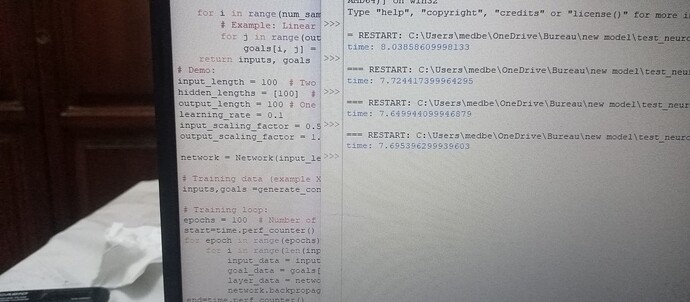Oh, so the behaviour will change basing on the “experience” of a creature, I see.
The behavior of the stimulated creatures will change depending on their experience during the run but the starting NN will not change, think of it like how all human babies are similar in intelligent but then with experience and environment they adapt new behaviors it’s the same all the individual of a speciy will have the same staring point but they will develop new behaviors as they live( get stimulated),
I think this is the hole point of developing neurons as living creatures ( to adapt to a very dynamic world )
Neural networks are pretty fast to run, even big ones (as long as we don’t get into the LLM networks with billions of parameters). What actually takes a long time is training the neural networks. So that would be why the game neural networks would need to be small as otherwise we would need a ton of simulation time to get the neural networks to evolve even some kind of competency in the game.
Also note that NNs aren’t perfect analogies for neurons and definitely not for biological evolution. if you have a specific idea, then I think NNs could be really powerful, but just because theyre cool and stuff, maybe not worth trying to figure out what problem they can solve or assuming simulating whole brains is a good idea.
“Creature Brain Simulation” was never thought of as a realistic idea to this point…
I thought as well of the same problem, I mean a few minutes are generally not enough to fully train a neuron network( I think a 3 layers with 100 neurons each will need around 10^5 training token to get a reasonably good results let’s say a training token takes twice the time of a normal activation of the main NN(the secondary one is always negligeable) then you could assume the speed of one training token will be 4X10^(-5)s ( this assumes that the CPU could moka a 10^9 operation per second) then the hole training process will be 4s nd then if there is 100 different species to makes those training to it then it will cost 400s which is more then 6 minutes)
However of a clever way to surpass this limit, what if the NN training is seen as an evolution in the brain structure of the organisme ? Then would split the training token on 10 generation effectively reducing the time by a factor of ran to more reasonably 40s per Auto-evo call it could be even modified on more turns( not really effective since we want a reasonable number of turns per game stage(I want it to be 100 hundred generation but it’s just overkill for game time) and in 5 minutes of actual game play and run time the creature will have a good enough responsiveness I think ![]() .
.
Now the thing is to port all this into the game…
Depending on which part then I have already a good implementation of NN on CPU , and I could probably even confirm the number of 4 second to be a good estimate( on my PC it runs way slower(2 times slower then 4s)
It will for sure take months to complete atleast…
This true and I think this thread should at least discuss feasibility so I’ll give my personal view
Yes,it’s feasible if the idea of those generation works good I think we can make it out even for 20 generation ( effectively adding 40s of auto-evo) coupled with maybe 5 time for a generation then those are (2+5)X 20. = 140 minute for the late multicellular stage) I think this is feasible if the auto evo and the hole process could be implemented
Is the “hole process” this whole NN duplication thing?
The hole process will be this :
1- create a main and a secondary NN for a spiciy
2- stimulate the learning during game play using the NNs created.
3-creation of new spiciy with a better NNs thanks to training the previous NNs during Auto-evo
Repeat this again( of course if the second spicy is more fit then the first one which explains the extenction of the first spiciy
Wouldn’t this sort of suggest that all species get smarter over time even if their brains shrunk in size significantly?
No and yes , look if you starting from rubbish NNs( not trained well enough) then this is absolutely true I mean losing a stupid neuron will not make a difference however when the spiciy have established a good enough intelligent through training over generation a loss of 1 neuron might lead to a big loss in the accuracy of it’s responses . It’s like the difference between in intelligent could be measured(noticed) well if the base is already high like if the human have some mental illness then it will be indetified later in life since all babies are relatively dump and a small change want be noticed until the baby start to be subject of some expectations ( be able to speak , to walk …)
By “spiciy” you mean species, right?
Absolutely, I mean anything that looks like spieces is good for me ( I really suck at English)
Your english might just be better than the one of a certain beloved forum user…
Some body say “English”?
anyway, here aproject that try to simulated a rl worm (brain include)
This project seems pretty dead nowadays.
So you are telling me there’s already a base to start from but won’t the world building in thrive be different then the ones in the openworm ? Moreover if you want to make some kind of intelligence emegence with NNs I could probably use numpy to create a creature that learns to navigate a 2D map to find food, avoid obstacles or threats however I think it’s completely useless for our current use
